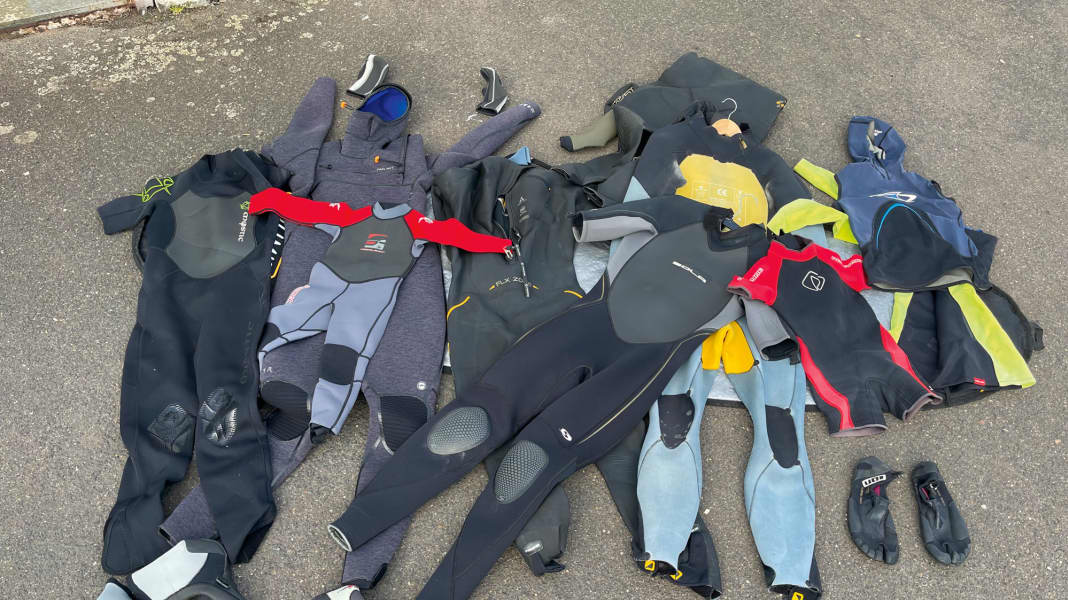
Whereas thick winter neoprene used to make you feel as immobile as a Michelin man, nowadays winter neos also offer full freedom of movement and the opportunity to have fun even at temperatures well below ten degrees.
Here are the most important tips so that you know what to look out for when choosing a wetsuit - whether in summer or winter:
What thickness for a wetsuit?
Regardless of the thickness, every wetsuit warms best when it fits close to the body so that as little water as possible can penetrate. It is therefore advisable to try it on before buying! The thickness of the neoprene determines how warm a suit is; it is always printed on the suit. The thickness is indicated with values such as 5/3, 4/3 or 3/2. These numbers stand for the neoprene thickness in millimetres on the body and the extremities - so 5/3 means five millimetres of neoprene thickness on the body and three on the arms and legs.
As the personal sensation of cold also depends heavily on gender, constitution and fitness level, the recommendations on page 33 should only be taken as a rough guide.
Types of surf suits
- Fullsuit: One-piece wetsuit with long arms and long legs, optionally with a zip on the back or in front of the chest. Winter-ready models are also available with an integrated bonnet.
- Steamer: Usually refers to a wetsuit with long legs and short arms.
- Long John: Neo with long legs and straps.
- Shorty: Neo with short arms and short legs.
Laminated or smooth-skin neoprene?
In general, a distinction is made between smooth-skin and laminated suits, regardless of thickness. Water rolls off smooth-skin neoprene (2) quickly and the evaporative cooling ("wind-chill effect") is reduced. Laminated neoprene (1) has a thin layer of nylon glued to the outside. This makes the suits very robust, but also increases heat loss due to higher evaporative cooling. A 5/3 smooth-skin wetsuit is therefore slightly warmer than a laminated wetsuit of the same thickness as soon as it gets wet in the wind. A sensible mix: smooth skin on the torso and laminated neoprene on the arms and legs to protect against abrasion and damage.

Size & fit of the surf suit
If you buy a wetsuit, you should try it on beforehand. Surfing suits should fit snugly around the body, especially at the neck and the arm and leg cuffs, so that no water gets in, but should offer enough freedom of movement in the important areas (arms, shoulders) and not be too tight. Otherwise you are bound to get fat arms after a very short time when surfing.
Upgrade tips for your Neo
These neoprene accessories belong in every well-stocked surf bag, as they allow you to expand your comfort zone considerably:
- Shoes: Protect feet not only from the cold, but also from injury. For summer, low shoes with two millimetres are sufficient, for winter surfers there are boots with up to seven millimetres. Be sure to pay attention: A Velcro fastener on the instep ensures a secure fit and should not be missing!
- Thermo undershirt: Thin neoprene underlayers are offered by almost all windsurfing brands, allowing you to significantly increase the thermal insulation of any neo for comparatively little money. For example, if you combine your classic 4/3 summer neo with a two-millimetre-thick thermal undergarment, you can surf with six millimetres of neoprene on your body until late autumn.
- Bonnet:A third of body heat is lost through the head. A bonnet is therefore essential in the cold season. It should fit snugly on the head and be fitted with a ruff that can be tucked under the neo.
- Neoprene hoodies:Neoprene jackets prevent you from cooling down quickly during surf breaks. Equipped with a trapeze slit, these can even be left on for surfing, although swimming is more difficult with the wide-cut jackets.

